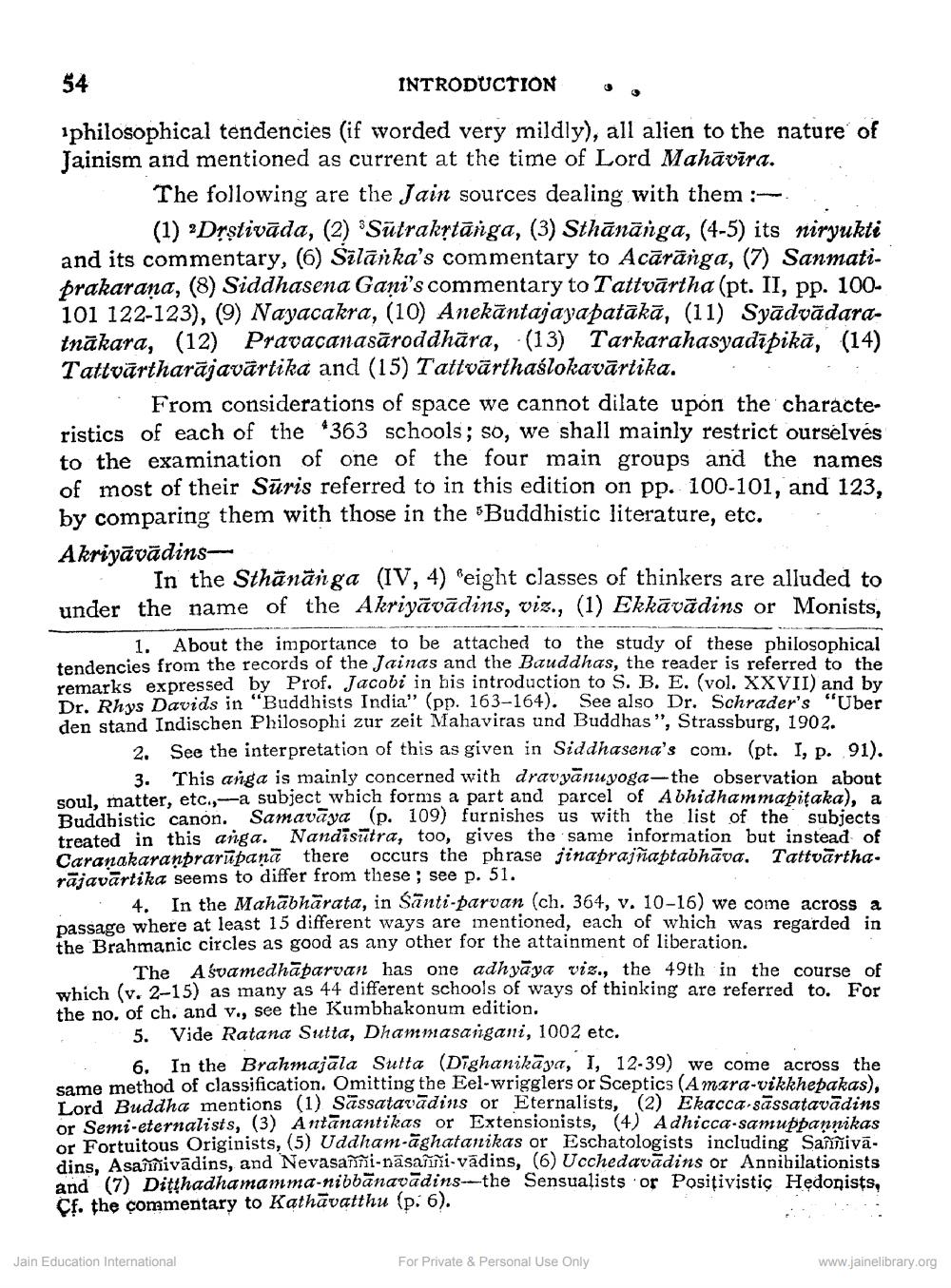________________
54
INTRODUCTION o. philosophical tendencies (if worded very mildly), all alien to the nature of Jainism and mentioned as current at the time of Lord Mahāvīra.
The following are the Jain sources dealing with them :
(1) Drştivāda, (2) Sutrakrtānga, (3) Sthānānga, (4-5) its niryukti and its commentary, (6) Silānka's commentary to Acārānga, (7) Sanmatiprakarana, (8) Siddhasena Gani's commentary to Tattvārtha (pt. II, pp. 100101 122-123), (9) Nayacakra, (10) Anekāntajayapatākā, (11) Syādvādaratnākara, (12) Pravacanasāroddhāra, (13) Tarkarahasyadīpikā, (14) Tattvärtharājavārtika and (15) Tattvärthaílokavārtika.
From considerations of space we cannot dilate upon the characteristics of each of the *363 schools; so, we shall mainly restrict ourselves to the examination of one of the four main groups and the names of most of their Sūris referred to in this edition on pp. 100-101, and 123, by comparing them with those in the Buddhistic literature, etc. . Akriyāvādins
In the Sthanānga (IV, 4) Beight classes of thinkers are alluded to under the name of the Akriyāvādins, viz., (1) Ekkāvādins or Monists,
1. About the importance to be attached to the study of these philosophical tendencies from the records of the Jainas and the Bauddhas, the reader is referred to the remarks expressed by Prof. Jacobi in his introduction to S. B. E. (vol. XXVII) and by Dr. Rhus Davids in "Buddhists India" (pp. 163-164). See also Dr. Schrader's "Uber den stand Indischen Philosophi zur zeit Mahaviras und Buddhas", Strassburg, 1902.
2. See the interpretation of this as given in Siddhasena's com. (pt. I, p. 91).
3. This anga is mainly concerned with dravyānuyoga-the observation about soul matter, etc.,--a subject which forms a part and parcel of Abhidhammapitaka), a Buddhistic canon. Samavāya (p. 109) furnishes us with the list of the subjects treated in this anga. Nandisitra, too, gives the same information but instead of Caranakaranprarūpana there occurs the phrase jinaprajnaptabhāva.Tattvārtha. rājavārtika seems to differ from these ; see p. 51.
4. In the Mahabharata, in Santi-parvan (ch. 364, v. 10-16) we come across a massage where at least 15 different ways are mentioned, each of which was regarded in the Brahmanic circles as good as any other for the attainment of liberation.
The Asvamedhāparvan has one adhyāya viz., the 49th in the course of which (v. 2-15) as many as 44 different schools of ways of thinking are referred to. For the no. of ch. and v., see the Kumbhakonum edition.
5. Vide Ratana Sutta, Dhammasaigani, 1002 etc.
6. In the Brahmajala Sutta (Dighanikaya, 1, 12-39) we come across the same method of classification. Omitting the Eel-wrigglers or Sceptics (Amara-vikkhepakas), Lord Buddha mentions (1) Sāssatavādins or Eternalists, (2) Ekacca.sassatavādins or Semi-eternalists, (3) Antānantikas or Extensionists, (4) Adhicca-samuppannikas or Fortuitous Originists, (5) Uddham-āghatanikas or Eschatologists including Sanivadins. Asamnivadins, and Nevasanii-nāsami vādins, (6) Ucchedavādins or Annihilationists and (7) Ditthadhamamma-nibbānavādins--the Sensualists or Positivistiç Hedonists, Cf. the commentary to Kathāvatthu (p. 6).
Jain Education International
For Private & Personal Use Only
www.jainelibrary.org




